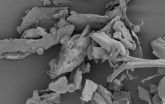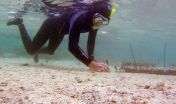The fear of trying new foods may have negative dietary implications
A study conducted at the UPV/EHU-University of the Basque Country has concluded that neophobic children have a lower quality index in terms of the Mediterranean diet
2015-08-26
(Press-News.org) This news release is available in Spanish.
The behaviour involving rejection of new foodstuffs is a typical phase in infant development, above all in 2- to 3-year-olds and which subsides around the age of 5. The children who go through dietary neophobia also display signs of anguish and anxiety and this behaviour may even turn into a habit in adulthood.
In her PhD thesis the researcher of the UPV/EHU's Faculty of Psychology Edurne Maiz conducted a study on 831 schoolchildren between the ages of 8 and 16. In the study she used questionnaires on infant neophobia -adapted for the thesis- in which the participants were asked about whether they were prepared to eat new foodstuffs. Various data were also gathered on the body composition of the participants as well as on their lifestyle (for example, diet and physical exercise), parental dietary styles and different variables (self-esteem and anxiety). From all this, explained the researcher, "we have found statistically significant differences in many variables".
The importance of parental style
Neophobic behaviour may have negative dietary implications insofar as it reduces the variety of food eaten. The neophobic participants displayed a lower quality index in terms of the Mediterranean diet, and this is mainly due to the reduced consumption of fruit and vegetables and an increase in foods regarded as being for occasional consumption.
On the whole, parents tend to control what, how much and when their children eat. Very often parents try to get their children to eat new foodstuffs; the pressure parents exert caused by the frustration they feel when the food is rejected may negatively affect the child's emotional state, and what is more, is associated with greater levels of neophobia. In the research, the neophobic children reported that their parents use the parental feeding style known as stimulation and less control than the parents of neophilic children (children who eat everything and who like to try new foodstuffs). "We have deduced," explained Edurne Maiz, "that parents basically control and stimulate a lot, but a moment comes when they give up because parental suffering is also present in all this."
As regards anxiety, the data lead one to understand that both in childhood and adolescence, the neophobes are more anxious than the neophiliacs. Likewise, with respect to self-esteem, neophobes scored in childhood less than the neophiliacs in the five dimensions studied within self-concept (family, social, physical, emotional and academic); and, in adolescence their scores in family and physical self-concept were lower.
In any case, no significant difference was found between them regarding body composition. "This could be due to the fact that there are nutritional supplements which at a given moment can be taken as a food supplement," said the researcher.
The researcher is keen "to send out a message to parents to be patient so that the cases of infant food neophobia do not develop or get worse," since "it has been seen that there are a considerable number of adults and children who have serious problems because of this," she explained. The researcher says that to avoid this problem it is important for there to be a strong parental bond with the child, and she also recommends "having a relaxed, pleasant atmosphere at mealtimes, that the children should participate in preparing the food and doing the shopping, using positive reinforcements and, finally, being a good model".
INFORMATION:
Additional information
Edurne Maiz Aldalur (Tolosa, Basque Country, 1982) has a diploma in Human Nutrition and Diet (University of Navarre, 2003), a degree in Psychology (UPV/EHU, 2010), and a Master's in Psychology of the Individual, Group, Organisation and Culture (UPV/EHU, 2011). She wrote up her thesis Lunch Time! Body composition, lifestyles, psychological variables and their relationship with food neophobia in childhood and adolescence at the Department of Personality, Evaluation and Psychological Treatment (PETRA) of the UPV/EHU's Faculty of Psychology under the supervision of Carmen Maganto-Mateo and Nekane Balluerka-Lasa. Right now, she is a post-doctoral fellow of the UPV/EHU and is working in the EFIGRO programme.
Bibliographical references
Maiz, E., Maganto, C. (2012). Evaluación de la Obesidad Infantil: IMC versus Bioimpedancia. En Asociación Española de Psicología Conductual (Eds.), Avances en Psicología Clínica (pp. 54-58). Madrid. ISBN: 978-84-695-3599-8
Maiz, E., Maganto, C., Balluerka, N. "Neofobia y otros trastornos restrictivos alimentarios en la infancia y consumo de frutas y verduras", Revista Española de Nutrición Comunitaria (pp. 150-157) ISSN 1135-3074. DOI:10.14642/RENC.2014.20.4.5029
ELSE PRESS RELEASES FROM THIS DATE:
2015-08-26
University of Alberta paleontologists have discovered a new species of lizard, named Gueragama sulamericana, in the municipality of Cruzeiro do Oeste in Southern Brazil in the rock outcrops of a Late Cretaceous desert, dated approximately 80 million years ago.
"The roughly 1700 species of iguanas are almost without exception restricted to the New World, primarily the Southern United States down to the tip of South America," says Michael Caldwell, biological sciences professor from the University of Alberta and one of the study's authors. Oddly however, iguanas closest ...
2015-08-26
The humble dust collecting in the average American household harbors a teeming menagerie of bacteria and fungi, and as researchers from the University of Colorado Boulder and North Carolina State University have discovered, it may be able to predict not only the geographic region of a given home, but the gender ratio of the occupants and the presence of a pet as well.
The new findings, which were published today in the journal Proceedings of the Royal Society B, highlight the impressive amount of microbial diversity in the average household and the degree to which these ...
2015-08-26
Dutch research shows that trained detectives of specialized observation teams are much better at registering details of a drug deal than ordinary civilians. Previous legal-psychological research revealed no relevant differences in observation skills between police professionals and civilians. The findings have been published in Legal and Criminological Psychology.
Judges and juries often assume that police officers' statements are more reliable than those of regular eyewitnesses. Because of this assumption, police officers' statements typically carry more weight in legal ...
2015-08-26
Only one in five gay and bisexual teen boys have been tested for HIV
HIV infections are on the rise for young men who have sex with men
Text messages, online program can identify nearby confidential testing sites
Testing in schools would 'normalize' the process.
CHICAGO --- Young men who have sex with men have the highest risk for HIV infection, but only one in five has ever been tested for HIV, a much lower rate than testing for non-adolescents, reports a new national Northwestern Medicine study conducted in partnership with the Center for Innovative Public ...
2015-08-26
On the coral reef, knowing who's your friend and who's your enemy can sometimes be a little complicated.
Take seaweed, for instance. Normally it's the enemy of coral, secreting toxic chemicals, blocking the sunlight, and damaging coral with its rough surfaces. But when hordes of hungry crown-of-thorns sea stars invade the reef, everything changes, reports a study to be published August 25 in the journal Proceedings of the Royal Society B.
Seaweeds appear to protect coral from the marauding sea stars, giving new meaning to the proverb: "The enemy of my enemy is my friend." ...
2015-08-26
Lecithin is an ingredient that you've probably never heard of, but one that plays a vital role in the production of chocolate and many other foods. It's never been clear how this ingredient works on a molecular level, and confectioners have relied on observational methods - essentially trial and error - to perfect their recipes.
Now, scientists have shown how the field of molecular dynamics (simulation on a molecular level) could be a valuable tool in understanding chocolate conching - the part of the chocolate-making process where aromatic sensation, texture and 'mouthfeel' ...
2015-08-26
Diseases of the heart and blood vessels are the most common cause of death in Europe, resulting in over four million deaths a year (45% of all deaths) according to the latest available figures published today (Wednesday) in the European Heart Journal [1].
Although deaths from cardiovascular disease (CVD) are declining in most of Europe, there are large inequalities between European countries, with higher death rates seen in Eastern Europe. These high death rates correspond to the lower life expectancy also found in these countries, indicating the impact of CVD on inequalities ...
2015-08-26
Doctors in Togo, West Africa have seen a 10% drop in tuberculosis death rates after redesigning diagnosis and treatment services in one of the country's health districts.
The full results are published in BMJ Quality Improvement Reports today - an open access forum to help clinicians share improvement ideas.
Tuberculosis (TB) is the second leading cause of death among infectious diseases worldwide, killing nearly 2 million people each year, mostly in less developed countries.
Even though there have been improvements in tuberculosis control over the past two decades, ...
2015-08-26
For the first time, UK physicians have demonstrated that antiviral-based therapies have the potential to protect humans from the deadly Ebola virus. The report, published in The Lancet Infectious Diseases journal, describes a case-series of eight British health-care workers who were evacuated to the Royal Free Hospital in London, UK after possible accidental exposure to Ebola virus in Sierra Leone between January and March 2015.
Four of the health-care workers were considered to have been at significant risk of exposure to Ebola from needlestick injuries and were given ...
2015-08-26
A new study from The Journal of Neuroscience shows that humans and rhesus monkeys have very similar abilities in recognizing objects "at a glance," validating the use of this animal model in the study of human visual perception. In the study, published August 26, humans and monkeys not only demonstrated similar ease in recognizing objects in varied positions and landscapes, but both species also tended to make the same errors.
For the study, researchers from MIT compared the performance of two rhesus macaque monkeys and 638 adult human subjects on a large set of object ...
LAST 30 PRESS RELEASES:
[Press-News.org] The fear of trying new foods may have negative dietary implications
A study conducted at the UPV/EHU-University of the Basque Country has concluded that neophobic children have a lower quality index in terms of the Mediterranean diet


